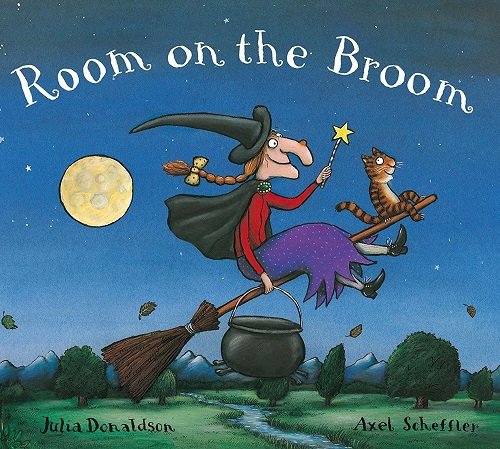
Room on the Broom
- irregular past tense
- possessive pronoun - her
- regular past tense
- speech sounds - /r/ clusters
- speech sounds - /w/
Review
A friendly witch and her cat are blissfully flying through the night sky on a broomstick. The wind unexpectedly blows the witch’s hat away, then her bow, followed by her wand! Fortunately, three kind animals find the witch’s belongings and end up taking a ride on her broomstick. But the witch’s broom snaps in half under the weight of all the new passengers, and they face the danger of being eaten by a hungry dragon!
Room on the Broom is a favourite picture book among many speech pathologists, teachers, and parents due to its mesmerising illustrations and repetitive rhyming text. Older children may be able to identify the moral of the story, which is about the importance of friendship and the benefits of being kind to others.
This book can be used to model a range of speech sounds but is particularly useful for words containing /r/ clusters (e.g. broom, dragon, frog) and words starting with the /w/ sound (e.g. witch, wand, wind). Room on the Broom is written in past tense, so it contains many examples of regular past tense verbs and irregular past tense verbs (e.g. flew, fell, found). It is also an excellent choice to target the possessive pronoun ‘her’ (e.g. she lost her wand, her hat blew off her head, etc.)
See the list below for further speech and language targets in Room on the Broom.
Book Details
Narrative Structure: Complex Episode
Story Plot: Conquering The Monster ; Losing Tale ; Repetitive Tale
- animals
- clothing
- dragons
- friendship
- halloween
- kindness
- witches
Speech and Language Targets
- /ch/ - chips, witch, search, ditch, squelch
- /d/ - down, dog, dark, bird
- /h/ - hat, hair, held, half, higher, help, horrible, heads
- /r/ - room, reeds, river, roar, thundering, forest, horrible, terrible, everyone
- /r/ clusters - broomstick, broom, breathing, dragon, dropped, dripping, dried, frog, frightful, grinned, ground, green, growl, grateful, cried, croak, shriek, through, threw, strode, spread
- /t/ tall, tail, tapped, tea, flutter, cat, hat, plait, spat
- voiced /th/ - the, their, they, then, there, that, them feathered
- unvoiced /th/ - thundering, without, something, with, through
- /w/ - witch, wore, wind, wailed, wildly, wagged, whoosh, wet, wand, wings
- adjectives (very tall hat, long ginger hair, stormy wind, green bird, horrible beast)
- adverbials (wildly, politely, eagerly, firmly)
- conjunctions (and, then, but)
- regular past tense
- irregular past tense verbs (flew, blew, threw, spat, found, leapt, fell, went)
- prepositions (in the water, on the broom, out, down, over, off)
- possessive pronoun (her)
- subjective pronouns (I, they)
- action verbs (fly, search, drop, clamber, flap, leap, throw)
- matching
- labelling
- identifying parts
- describing
- predicting
- explaining means to a goal
- location concepts (in, on, out, up, down, off, over)
- quantity concept (half)
- friendship
- kindness
- joining in
- character description
- weather
- sequencing
- initiating event
- problem
- feelings
- resolution
- moral
- dialogue
- direct character speech
- repetition for emphasis
- rhyme
Book Info
Published by Penguin Books Australia in 2003 (ISBN: 9780142501122)

